Inside Olga Bell’s Brooklyn apartment, where she conceived new album ‘Tempo’
The Russian American shows us her things
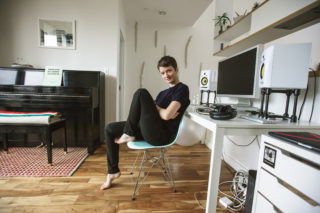
The Russian American shows us her things
Olga Bell left Russia at the age of 7 to spend her formative years in Alaska; that most northern of U.S. states that bizarrely has Canada between it and the rest of America. While her friends were out skiing, Bell spent whole days sat at the piano, which is how she went on to graduate from Boston’s New England Conservatory – the country’s oldest and most reputable music school. She’s lived in New York for the past decade (playing in Dirty Projectors and Chairlift), and in her own corner of Williamsberg, Brooklyn, for the past five years, a block away from renowned alt. venue the Knitting Factory. She lives here, in a minimal, mezzanine apartment, with her partner – a designer. “Clean, empty space helps you think,” she says in her breezy way when I note just how ordered and stylish her home is.
It was here that Olga wrote her forthcoming third album, ‘Tempo’, which in many ways flips 2014’s ‘Krai’ on its head. Performed entirely in Russian and centred in traditional Russian folk music, ‘Krai’ was as intellectual as it sounds, with each of its 9 songs representing a different region of Bell’s homeland. ‘Tempo’ has been no less academically conceived and produced, but it sure is more accessible. She describes it as “a record first for the body, then for the mind.” It’s her exploration into club music and dance culture, inspired by the 1991 documentary movie Paris Is Burning, itself a chronicle of New York’s late ’80s gay ball culture.
“Even though I’m not a direct participant in that demographic, I was so inspired by how everything felt, and the energy of it,” she says. “And it being deeply connected to the community. I wanted to see if some of that energy was still around New York. I didn’t go specifically to vogue nights or gay clubs; I just wanted to gauge the general dance landscape. I wasn’t looking for Paris Is Burning, or those bankers and models gross clubs that have evolved over the last 20 years – I wanted to see if there are places where you can just go and listen to great music, where there’s no judgment and people of all ages and orientations.”
Olga says she found the community she was looking for by forcing herself to go dancing alone, at New York spots like Cielo and Output. After a month or two of partying she returned home to start work on ‘Tempo’, which is far from a record of mindless bangers. Tracks like ‘Randomness’ and ‘Ritual’ are clearly inspired by early ’90s club music, but Bell’s love for a slower BPM – and in particular Portishead and West Coast hip-hop – also permeates songs like the Bjork-ish ‘Doppio’ and the screwy ‘ATA’.
She jokes by insisting that all the late nights out were “for research, quote-unquote,” but I believe her. ‘Tempo’ is a dance record that’s too strange and varied to not have been masterfully planned. From her days studying the nuances of classical piano, I’m not surprised to hear that she now feels compelled to learn how to mix records in order to fully understand the type of music she’s now making.
“You can kind of be anybody in a club,” she tells me as we tour around her place. “You can be that person who’s totally sober and losing their shit in the centre of the dancefloor – it’s totally fine. You can leave your life behind. I don’t meditate, but I feel like dancing can fill a similar need.”
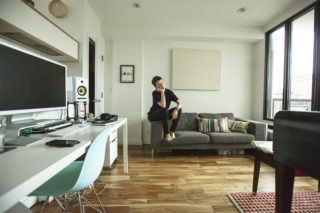
You can’t see it, but there’s white embroidery on this canvas. It’s an artist called Mario Hugo, who’s done a lot of great album covers, like the Lorde ‘Pure Heroine’ artwork. My boyfriend knows him – he’s a designer, which is another reason we’ve got this minimal feel going on. The embroidery says, ‘Nowhere to go and everything to see.’
This is a photo that my friend, Alix, took in Alaska. She’s a photographer and gave it to me because it’s where I grew up. I moved to Alaska from Russia when I was 7 and lived there until I went to college in Boston, where I studied classical piano at New England Conservatory. Alaska is beautiful. The air is sweet and clean there. But I wasn’t super outdoors-y because I had to stay inside and practice the piano.
When I first moved to New York I taught a lot of piano lessons as a means to supporting myself while I figured out what I was going to do with my life – I was learning Ableton and going to open mic nights and teaching piano. These lovely students who were moving to Singapore gave me this piano, which was very fortunate. For the first three years that I was in New York I didn’t have a piano, and that was hard. These days I don’t play the piano much at all, because I’m always on Ableton, on the computer, but I used to play for 4 or 5 hours a day. I’m preparing for a tour at the moment, so it’s all about sequencing and singing. I kind of struggle with being a front person a bit, and putting on a show rather than performing a piano recital, because I think that it’s hard to get recognition as a producer when you’re also the principle performer of the music – people presume that you didn’t produce the music if you’re singing it. Sometimes I wonder if I should just shut up and stop singing so that people would appreciate the whole production is part of the work.
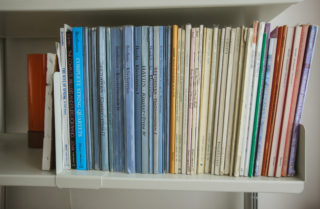
This is my past life. But what’s good about concert music is that you can always go back to it. The popular, performing, touring club world is for the young. If you’re doing it when you’re 50… I don’t know, I’m about to make an ageist comment, which I don’t mean to do – I mean to compliment classical music in that you can do it your entire life. What I really appreciate from my schooling in classical music is that there’s this really intense attention to detail – what are you meaning with a certain phrase? And one of the things that inspired the whole idea of ‘Tempo’ is how the pace of something can set up this whole mood world. So some of the songs are obviously dance songs, but others are pretty slow, and I was thinking about the most compelling, physically active music at the super low end of the BPM spectrum. That for me is the first Snoop Dogg record and Portishead and Massive Attack. ‘Dummy’ is SO good. There’s so much feeling in Beth Gibbons’ voice, and so much groove.
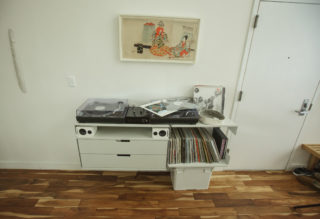
I discovered Aphex Twin when I went to Boston for music school, so I was 18. I got ‘Drukqs’ when it came out in 2001. I just picked it up in a store and thought it was amazing – its crazy piano cover and the weird, jumbled song titles – and I hadn’t really heard Aphex Twin, but I got it and it blew my mind. It was all I listened to for a year, and I would go running to ‘Vordhosbn’. From there I got Boards of Canada and Squarepusher and Autechre, and I went down that Warp rabbit hole.
I’m currently learning how to mix records. It comes from making this record inspired by clubs. I thought, if you’re to understand anything about club music, you have to learn to DJ with vinyl. It’s really difficult, and I haven’t mastered it yet. For me it always turns into one polyrhythmic mass, and I enjoy that. I keep reminding myself, no, stop listening to these weird rhythms, try to align them. I’m basically just playing two records at the same time.
We got this print on a trip to Kyoto. It’s really cool because we were just shopping around this old print store, and it’s really old, and it’s got this crazy orange colour in it that looks like neon. I don’t know how they got it like that back then.
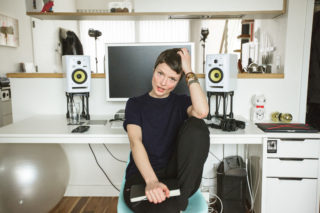
Traditionally, the Kit-Cat clock is black and white, and that’s what inspired my album art. I think it’s the happiest little time-keeper, and I wish that when I was a kid – I mean, I spent hours with metronomes, practicing – and if metronomes had looked like the Kit-Cat clock it would have been a lot more fun. I know it’s a little bit of a stretch to look at the album cover and think of the clock, but we tried giving me vertical pupils but it just made me look like a snake.
I got this shaker in Brazil, and I call it my C-3P0 shaker. It sounds really good. I used to use it all the time.
Have you heard about how toxic sitting is? Y’know, there’s all these articles about how we’re dying from sitting. Sitting on the ball is still sitting, but you’re bouncing around and your leg muscles are firing as you’re stopping yourself from falling over.
Have you ever heard of a jaw harp? Some people call them Jew Harps, but that’s not very PC at all. It goes boing boing boing and makes this springy noise. It’s a traditional folk instrument that they have in Russia, and they have it here in America, from bluegrass music. The second movement on ‘Krai’ was this region called ‘Altai’, and the indigenous music of that place has the signature sound of the jaw harp. I taught myself to play it and recorded it in the closet.
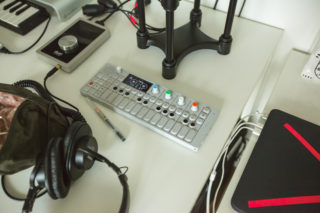
This is one of my favourite things in the world – the OP-1 from Teenage Engineering. I’ve used it for years on all my records. And I’ve used it live, and when I was touring with Dirty Projectors. If you look on YouTube, there’s a cover Dirty Projectors did of Usher’s ‘Climax’ for Triple J’s Like A Version series, and I’m using it there. You can do so much with this thing. There’s, like, 8 different synthesiser engines, a ton of different sampling drum machines, a 4-track sequencer, you can sample the radio… It’s just awesome. It’s my favourite piece of outboard gear.